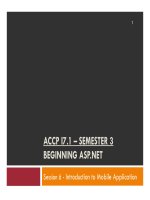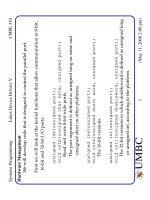31 Slide CCNA qos
Bạn đang xem bản rút gọn của tài liệu. Xem và tải ngay bản đầy đủ của tài liệu tại đây (717.21 KB, 26 trang )
Introduction to IP QoS
Introducing QoS
BSCI v3.0—2-1
Converged Network Quality Issues
Converged traffic characteristics:
• Constant small-packet voice flow competes with bursty data flow.
• Critical traffic must get priority.
• Voice and video are time-sensitive.
• Brief outages are not acceptable.
Converged Network Quality Issues (Cont.)
• Lack of bandwidth: Multiple flows compete for a limited
amount of bandwidth.
• End-to-end delay (fixed and variable): Packets have to
traverse many network devices and links that add up to the
overall delay.
• Variation of delay (jitter): Sometimes there is a lot of other
traffic, which results in increased delay.
• Packet loss: Packets may have to be dropped when a link is
congested.
QoS Defined
Implementing QoS
1. Identify traffic and its
requirements.
2. Divide traffic into
classes.
3. Define QoS policies for
each class.
Identify Traffic and Its Requirements
• Network audit: Identify traffic on the network.
• Business audit: Determine how important each type of traffic
is for business.
• Service levels required: Determine required response time.
The Requirements of Different Traffic Types
QoS Policy
• A networkwide definition of
the specific levels of QoS
assigned to different
classes of network traffic
Classification
• Classification is the process of identifying and categorizing
traffic into classes, typically based upon:
– Incoming interface
– IP precedence
– DSCP
– Source or destination address
– Application
• Classification is the most fundamental QoS building block.
• Without classification, all packets are treated the same.
Marking
• Marking is the QoS feature component that “colors” a packet
(frame) so it can be identified and distinguished from other
packets (frames) in QoS treatment.
• Commonly used markers:
– Link layer:
• CoS (ISL, 802.1p)
• MPLS EXP bits
• Frame Relay
– Network layer:
• DSCP
• IP precedence
Trust Boundaries: Classify Where?
For scalability, classification should be enabled as close to the
edge as possible, depending on the capabilities of the device at:
1. Endpoint or end system
2. Access layer
3. Distribution layer
Implementing QoS Policy
Using a QoS Service Class
Implementing QoS Policy Using
a QoS Service Class (Cont.)
• Profile applications to their basic network requirements.
• Do not overengineer provisioning; use no more than four to five
traffic classes for data traffic:
– Voice applications: VoIP
– Mission-critical applications: Oracle, SAP, SNA
– Interactive applications: Telnet, TN3270
– Bulk applications: FTP, TFTP
– Best-effort applications: E-mail, WWW
– Scavenger applications: Nonorganizational streaming and video
applications
• Do not assign more than three applications to mission-critical or
transactional classes.
• Use proactive policies before reactive (policing) policies.
• Seek executive endorsement of relative ranking of application
priority prior to rolling out QoS policies for data.
Implement the DiffServ QoS Model
Introducing Queuing Implementations
BSCI v3.0—2-14
Congestion and Queuing
• Congestion can occur at any point in the network where there are
points of speed mismatches or aggregation.
• Queuing manages congestion to provide bandwidth and delay
guarantees.
Congestion and Queuing
Queuing Algorithms
• First in, first out (FIFO)
• Priority queuing (PQ)
• Round robin
• Weighted Fair Queue.
• Class Based Weighted Fair Queue.
Implement the DiffServ QoS Model
Introducing Traffic Policing and Shaping
BSCI v3.0—2-18
Why Use Shaping?
• To prevent and manage congestion in ATM, Frame Relay, and
Metro Ethernet networks, where asymmetric bandwidths are
used along the traffic path
• To regulate the sending traffic rate to match the subscribed
(committed) rate in ATM, Frame Relay, or Metro Ethernet
networks
• To implement shaping at the network edge
Why Use Policing?
• To limit access to resources when high-speed access is used
but not desired (subrate access)
• To limit the traffic rate of certain applications or traffic
classes
• To mark down (recolor) exceeding traffic at Layer 2 or
Layer 3
Traffic Policing and Shaping Example
• Central to remote site speed mismatch
• Remote to central site oversubscription
• Both situations result in buffering and in delayed or dropped
packets.
Policing vs. Shaping
•
•
•
•
Incoming and outgoing directions.
Out-of-profile packets are dropped.
Dropping causes TCP retransmits.
Policing supports packet marking or
re-marking.
• Outgoing direction only.
• Out-of-profile packets are queued
until a buffer gets full.
• Buffering minimizes TCP
retransmits.
• Marking or re-marking not
supported.
• Shaping supports interaction with
Frame Relay congestion indication.
Single Token Bucket
If sufficient tokens are available (conform action):
• Tokens equivalent to the packet size are removed from the
bucket.
• The packet is transmitted.
Single Token Bucket (Cont.)
If sufficient tokens are not available (exceed action):
• Drop (or mark) the packet.
Single Token Bucket (Cont.)
If sufficient tokens are not available (exceed action):
• Drop (or mark) the packet.









